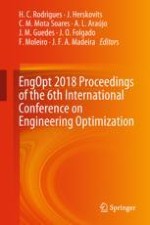2019 | Book
EngOpt 2018 Proceedings of the 6th International Conference on Engineering Optimization
Editors: Prof. Dr. H.C. Rodrigues, Prof. Dr. J. Herskovits, C.M. Mota Soares, Prof. Dr. A.L. Araújo, Prof. J.M. Guedes, J.O. Folgado, F. Moleiro, J. F. A. Madeira
Publisher: Springer International Publishing
